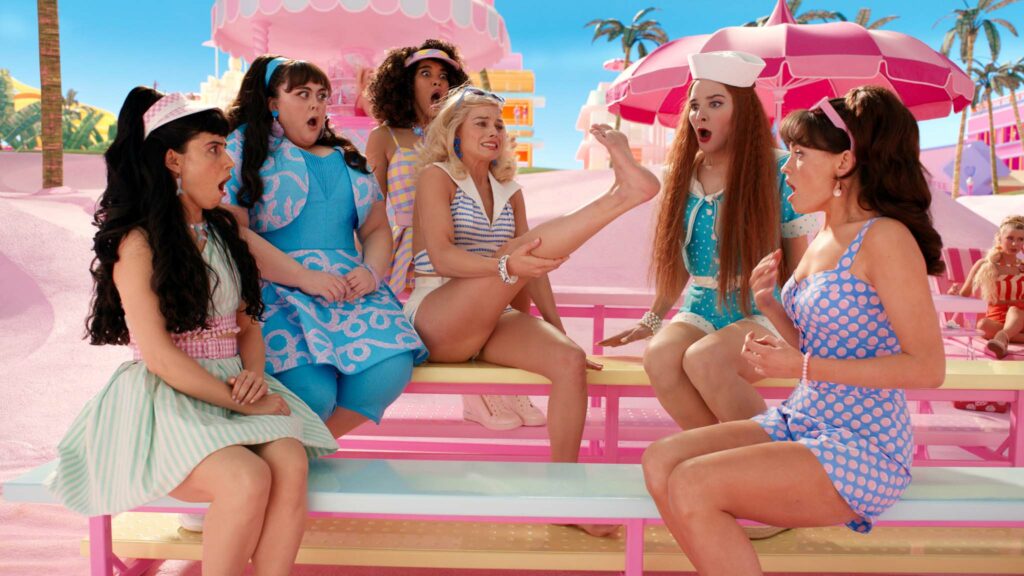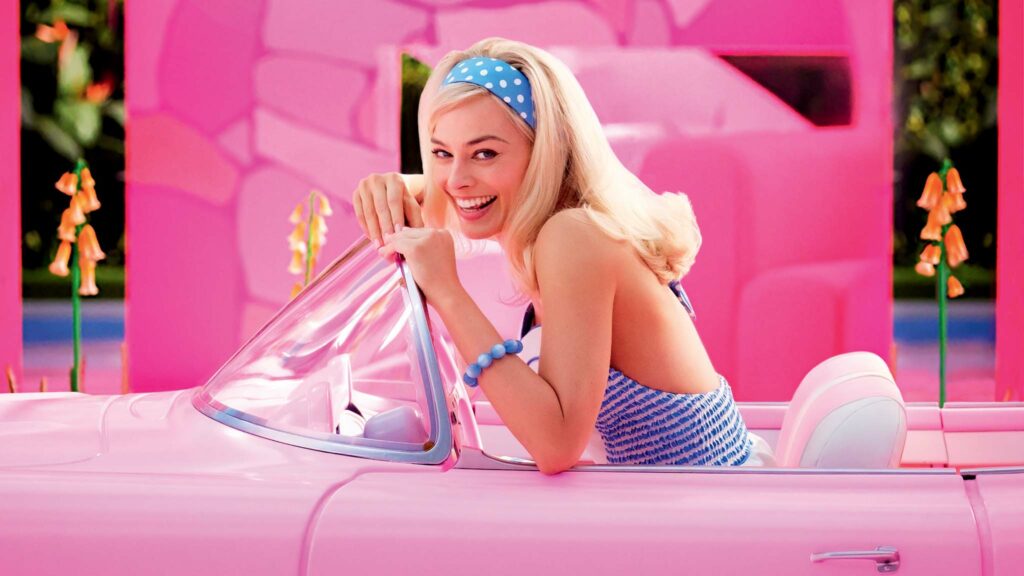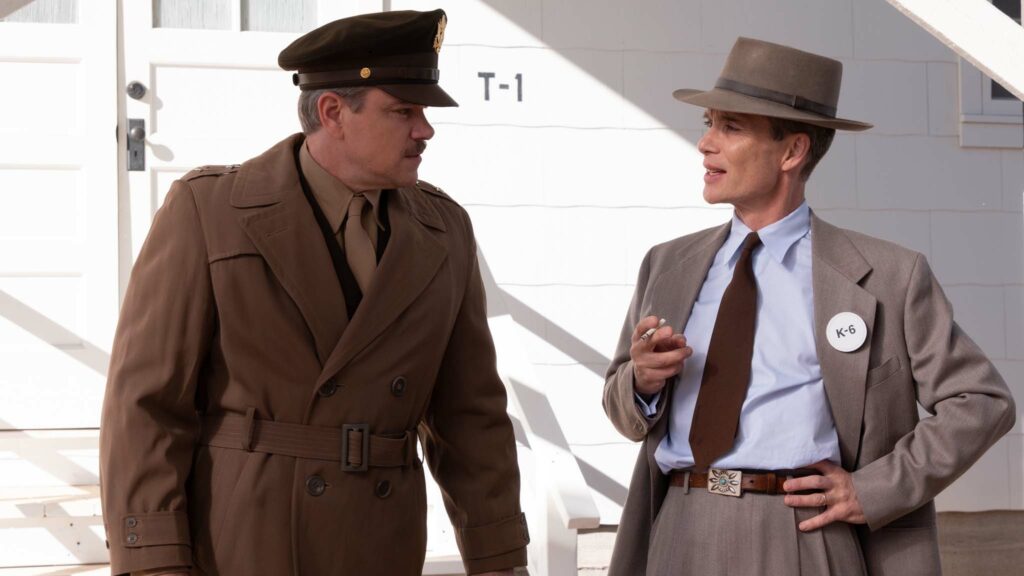Comedy
Barbie (12A)
Review: Margot Robbie is in the pink in Oscar-nominated writer-director Greta Gerwig’s uneven satire of modern gender roles based on the enduringly popular fashion dolls. Moments of comic brilliance punctuate a script co-written by Gerwig and real-life partner Noah Baumbach, such as when the narrator (Helen Mirren) offers pithy commentary about one Barbie’s empowering outburst, Ryan Gosling’s Ken earnestly croons an emasculation anthem composed by Mark Ronson and Andrew Wyatt, and the neglected companion doll enthusiastically embraces “the patriarchy”. However, the screenwriting by two of contemporary cinema’s sharpest wits is infuriatingly inconsistent. Jokes that miss intended targets outweigh the zingers and amusing cameos such as Rob Brydon’s Sugar Daddy Ken (a bona fide figure with a West Highland Terrier named Sugar) are largely afforded single lines of forgettable dialogue.
Gerwig’s picture glides through decades of toy history dating back to the late 1950s and affectionately pokes fun at commercial misfires such as the Growing Up Skipper doll, whose breasts enlarged when you rotated her arms. Using Robbie’s conflicted heroine as a twinkly-eyed mouthpiece, Gerwig and Baumbach enforce timely messaging about sisterly solidarity and independence, openly challenge chauvinistic behaviour and rebuke outdated attitudes about women’s roles in society. No-one is going to put this opinionated, trailblazing Barbie in a box… except for the purposes of merchandising.
Life in Barbie Land is perfect for one stereotypical Barbie (Robbie), exchanging cheery affirmations with neighbours and acknowledging her dreamily chiselled beau, Ken (Gosling). The titular blonde suffers an existential crisis that includes nagging thoughts of death and an opportunity to ditch her high heels for – gasp – sensible flat-soled footwear. Faced with expulsion from pink-saturated utopia, Barbie visits her socially ostracised sister, Weird Barbie (Kate McKinnon), who identifies a fissure in the thin membrane separating Barbie Land from our reality.
“Go to the real world and find the girl who’s playing with you,” advises Weird Barbie, prompting stereotypical Barbie to embark on an odyssey of self-discovery. Ken gatecrashes the road trip with his trusty pair of yellow rollerblades. The anatomically restricted duo are gobsmacked by rampant inequality in present-day California as they cross paths with a despairing mother (America Ferrera) and cynical daughter (Ariana Greenblatt), and an insensitive Mattel chief executive (Will Ferrell).
Barbie astutely taps into decades of childhood nostalgia, anchored by an effervescent performance from Robbie as the self-doubting embodiment of so-called physical perfection. Madcap beach vibes and a rousing power ballad solo recall the superior 2021 comedy Barb And Star Go To Vista Del Mar, also starring Annie Mumolo. Gosling’s directionless hunk is ultimately more endearing than the title character, embracing the lunacy of a bare-chested sidekick for Barbie who is destined “to live and die a life of blonde fragility”. That’s Kentertainment.
Find Barbie in the cinemas
Thriller
Oppenheimer (15)
Review: Inspired by Kai Bird and Martin J Sherwin’s Pulitzer Prize-winning book, writer-director Christopher Nolan’s sweeping biographical drama commemorates the complex and brilliant mind credited with nurturing mankind’s relationship with atomic weaponry. An ambitious but dramatically necessary three-hour running time, which dwarfs The Dark Knight Rises and Interstellar, feels considerably shorter in the mesmerised moment and shouldn’t dissuade audiences from luxuriating in Nolan’s grandiose vision, anchored by a showstopping lead performance from Cillian Murphy.
Oppenheimer continues Nolan’s love affair with the immersive IMAX format and his barnstorming picture makes history as the first film with sequences shot on black and white IMAX film. Different palettes elegantly navigate two timelines and juxtapose the theorical physicist’s rise and fall during the dark days of the McCarthy witch-hunts.
Lustrous colour sequences captured by cinematographer Hoyte Van Hoytema, dubbed Fission, concentrate on Oppenheimer’s journey from the hallowed halls of Cambridge University in 1924 to the politically motivated humiliation of a secret 1954 hearing to determine his security clearance via a 1947 appointment to the Institute for Advanced Study in New Jersey under director Lewis Strauss (Robert Downey Jr).
Black and white vignettes, dubbed Fusion, fixate on Strauss’s appearance before combative members of the Senate to secure the votes to confirm his nomination as President Eisenhower’s Secretary of Commerce following a divisive tenure as chair of the United States Atomic Energy Commission. The connective tissue between colour and monochrome is the Manhattan Project led by General Leslie Groves Jr (Matt Damon) to research and develop a devastating weapon capable of ending the Second World War. Groves appoints Oppenheimer as scientific director despite his personal ties to Communist Party members including younger brother Frank (Dylan Arnold) and American physicist Jean Tatlock (Florence Pugh).
Oppenheimer coolly rationalises his involvement – “I don’t know if we can be trusted with such a weapon but I know the Nazis can’t” – and dedicates every waking hour to perfecting an atomic device at a secret site south of Los Alamos. His biologist wife Kitty (Emily Blunt) joins other families in New Mexico to witness the dawn of a new age of self-destruction, culminating in the 1945 bombings of Hiroshima and Nagasaki.
Oppenheimer is a directorial tour-de-force matched by Murphy’s exquisitely layered portrayal of the son of German Jewish immigrants, who feels personally compelled to act (“It’s not your people they’re herding into camps, it’s mine”). Blunt and Downey Jr catalyse strong support and Swedish composer Ludwig Goransson, who worked on Nolan’s last picture Tenet, complements dazzling visuals with a bombastic score that seems to rattle every fixture and fitting of the cinema. The fuse of Nolan’s picture may be three hours long and winding but when the beautifully arranged atoms of Oppenheimer collide, tension builds and ultimately detonates with meticulously engineered and unstoppable force.
Find Oppenheimer in the cinemas









